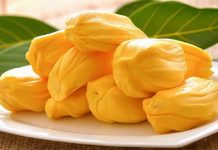Scientific name: Morinda citrifolia L.
Family: Rubiaceae
Synonym: Morinda macrophylla Desf.
Bengali/Vernacular name: Noni, Ach, Banach, Barachand, Haldi kachu.
Tribal name: Ken-thug-blag (Khasia), Rimi owa rih (Marma).
English name: Indian mulberry, Great morinda.
Description of the plant: A shrub or small tree, stem obtusely 4-angled, glabrous. Leaves are broadly elliptic to oblong, 12-25 cm long, with pointed or blunted tips. Flowers 5- merous, white, in dense ovoid heads. Fruits compound, fleshy, white, or greenish white, ovoid.

Plant parts used: Leaf, bark, fruit.
Ethnomedicinal uses: Decoction of leaves is used for the treatment of diarrhoea.
Fruit juice used as a gargle for sore throat.
A powder is made with the dried leaves of the plant and then fume is obtained from the dried powder inhaled four times a day until the anal blister is cured.
A fresh juice is extracted from the leaves of the plant is taken twice a day (two tea spoons amount each time) for one week to treat irregular menstruation.
Fresh juice extracted from the leaves of the plant is taken after adding some sugar thrice a day until the jaundice is cured.
A decoction is made with the bark of the plant is taken to treat fever.
Leaf juice is used for the treatment of rheumatoid arthritis.
Heated leaves are applied to the chest and abdomen to treat cough and enlarged spleen.
The fruits of the plant are used to treat dysentery and leucorrhoea.
Juice of over-ripe fruit used for diabetes.
Juice is extracted from the leaves of the plant is applied to relieve pain in gout.
Distribution: It occurs in Bhola, Chittagong, Cox’s Bazar, Dhaka, Dinajpur, Manikganj, Noakhali, Rajshahi, and Tangail districts.
Is this plant misidentified? If yes, please tell us….















… [Trackback]
[…] Information on that Topic: natureinfo.com.bd/morinda-citrifolia/ […]
… [Trackback]
[…] Find More on that Topic: natureinfo.com.bd/morinda-citrifolia/ […]
… [Trackback]
[…] Information to that Topic: natureinfo.com.bd/morinda-citrifolia/ […]
… [Trackback]
[…] Info on that Topic: natureinfo.com.bd/morinda-citrifolia/ […]